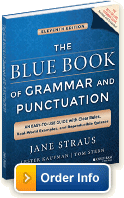|
Welcome to your GrammarBook.com e-newsletter.
|
“As someone who routinely bemoans the death of proper English, I would like to thank and commend you for your newsletter.”
—Barry S.
“GrammarBook.com is a life-saver. I’m writing all the way from Jamaica!”
—Addolethia G.
“I eagerly look forward to your weekly e-newsletter and the pop quizzes. Love them!”
—Kathy D.
|
|
|
Apostrophes: Not Always Possessive
Apostrophes’ chief purpose is to show possession, but these marks have other functions, too. They alert readers when, and where, one or more letters are
missing from a word, such as the no that is dropped when cannot becomes can’t. Or they create separation to avoid confusion when
two elements are combined for special reasons. For example, in When Colin writes a’s, they look like u’s, the apostrophes prevent us from thinking
that the writer meant as and us. It’s hard to imagine any credible writer not using apostrophes for a’s and u’s, but
beyond that, apostrophe unanimity is hard to find.
Apostrophes have a complicated relationship with plurals. Different writers have different approaches when writing the plural forms of abbreviations, some
letters and numbers, and words that do not normally take plurals.
• What’s the plural of an abbreviation with periods, like Ph.D.? There’s no right answer. Some write Ph.D.s, some write Ph.D.’s.
• Most writers use apostrophes when pluralizing single capital letters (I earned three A’s), but there are some who would write three As. With groups of two or more capital letters, apostrophes seem less necessary (two new MPs, learn your ABCs), but some
writers insist on them.
• Single-digit numbers are usually spelled out, but when they aren’t, you are just as likely to see 2s and 3s as 2’s and 3’s. With
double digits and above, many (but not everyone) regard the apostrophe as superfluous. Most writers nowadays favor the 1900s, but some go with the 1900’s. If numerals are used to identify decades, the ’30s is widely used, but you will also see the 30’s, and occasionally
even the ’30’s.
• A keyboard caveat: it takes extra effort to generate an apostrophe when it is the first character in numbers or words like the ’30s or ’tis (for “it is”). If you’re not careful, you’ll instead type an opening single quotation mark (‘), which is a backward and
upside-down apostrophe. The result will be the ‘30s and ‘tis, which finicky readers consider an indefensible lapse.
• Making words plural with ’s is usually a big mistake, but some writers, as a courtesy to readers, will add ’s to words that don’t
ordinarily become plural, as in no if’s, and’s, or but’s, or here are some do’s and don’t’s. Since two apostrophes in one word look
clunky, you are more likely to see do’s and don’ts, which looks better, although don’ts is inconsistent with do’s. A better
option might be to use italics to establish differentiation: no ifs, ands, or buts; some dos and don’ts.
• Let’s close with a possessive-apostrophe principle that confuses a lot of people. For the plurals of familiar compound nouns like driver’s license and master’s degree, the apostrophe stays the same; the plurals are driver’s licenses and master’s degrees. You may ask why not drivers’ licenses—after all, we’re talking about more than one driver, aren’t we? Well, yes and no.
The driver’s in two driver’s licenses denotes that each license was issued to one driver only. The same reasoning applies to master’s degrees.
No punctuation mark causes more confusion and dissent than apostrophes. If we could get together on the rules, maybe people would use them more.
Because of the e-newsletter’s large readership, please submit your English usage questions through GrammarBook.com’s “Grammar Blog.” |
|
Pop Quiz
Find the incorrect sentence(s).
1. You used too many ands in that paragraph.
2. Today’s multiplication exercise will focus on 6’s and 7’s.
3. The decade of the ‘80s was marked by scandals.
4. In her note, the Ls all looked like Es.
Free BONUS Quiz for You!
[[firstname]], because you are a subscriber to the newsletter, you get access to one of the Subscription Members-Only Quizzes. Click here to take an Apostrophes Quiz and get your scores and explanations instantly!
Good News for Quiz Subscribers
First, we are excited to inform our instructor-level quiz subscribers of several significant improvements to your subscription at no added cost to you:
- You may opt out of receiving e-mails when students complete quizzes.
- You may now assign multiple quizzes at a time.
- You may now assign a starting date and ending date when quizzes will be available to students.
- You can now download a spreadsheet containing the results of all quizzes taken by each student.
Second, after logging on, all quiz subscribers may now enjoy GrammarBook.com free of advertisements (excluding the Grammar Blog).

“So convenient … hundreds of quizzes in one click.”
[[firstname]], Subscribe to receive hundreds of English usage quizzes not found anywhere else!
- Take the quizzes online or download and copy them.
- Get scored instantly.
- Find explanations for every quiz answer.
- Reproduce the quizzes to your heart’s content.
- EASY to use.
- No software to download.
- No setup time.
- A real person to help you if you have any questions!
“Fun to test my skills!”
“The explanations really help … thanks!”
Your choice: Subscribe at the $29.95 or $99.95 level ($30 off - regularly $129.95).
“I download the quizzes for my students who don’t have computer access.”
Subscribe today to receive hundreds of English usage quizzes not found anywhere else!
“Makes learning English FUN!”
 |
Don’t need all the quizzes at once?
You can now purchase the same quizzes individually for ONLY 99¢ each. Purchase yours here. |

Get Yours Today!
Get Amazon’s No. 1 Best-seller in Four Categories!
No. 1 in Grammar
No. 1 in Reading
No. 1 in Lesson Planning
No. 1 in Vocabulary |
The Blue Book of Grammar
and Punctuation
by Jane Straus, Lester Kaufman, and Tom Stern
The Authority on English Grammar!
Eleventh Edition Now Available
Have You Ordered Your Copy Yet?
An indispensable tool for busy professionals, teachers, students, homeschool families, editors, writers, and proofreaders.
Available in print AND as an e-Book! Over 2,000 copies are purchased every month!
Order Your Copy Today!
- Hundreds of Grammar, Punctuation, Capitalization, and Usage Rules
- Real-World Examples
- Spelling / Vocabulary / Confusing Words
- Quizzes with Answers
The publisher is extending its pre-publication discount offer until August 30! If you live in the United States or Canada, order the new edition of The Blue Book
through Wiley.com and get 30 percent off and FREE shipping. Simply go to bit.ly/1996hkA and use discount code E9X4AYY.
For those of you who live outside the U.S. and Canada, although the publisher is not able to offer free shipping, you will get 35 percent off to help offset your shipping costs. Simply go to bit.ly/1996hkA and use discount code E9X4A. |
Changes Have Begun on Our GrammarBook.com Website
We want to alert all our newsletter readers and visitors to our website that we have begun updating the English Rules section of GrammarBook.com to reflect the contents of the eleventh edition of The Blue Book of Grammar and Punctuation. So far, all of the Grammar Rules have been updated. The remaining revisions will take place over the next couple of months.
We researched the leading reference books on American English grammar and punctuation including The Chicago Manual of Style, The Associated Press Stylebook, Fowler’s Modern English Usage, Bernstein’s The Careful Writer, and many others. As before, we will provide rules, guidance, and examples based on areas of general agreement among these authorities. Where the authorities differ, we will emphasize guidance and provide options to follow based on your purpose in writing, with this general advice: be consistent.
 Wordplay Wordplay
Following are more selections from a perverse set of rules that are guilty of the very mistakes they seek to prevent. English teachers, students, scientists, and writers have been circulating these self-contradictory rules for more than a century.
Rules for Writing Good: Writing Tips
1. Avoid annoying, affected, and awkward alliterations, always.
2. Never, ever use repetitive redundancies.
3. At the end of the day, the bottom line is to bag trendy locutions that sound flaky.
Pop Quiz Answer
Three of the sentences would be acceptable to at least some editors and publishers. The one incorrect sentence is No. 3: The decade of the ‘80s was marked by scandals. Make it ’80s, with an apostrophe.
Learn all about who and whom, affect and effect, subjects and verbs, adjectives and adverbs, commas, semicolons, quotation marks, and much more by just sitting back and enjoying these easy-to-follow lessons. Tell your colleagues (and boss), children, teachers, and friends. Click here to watch. |




 Wordplay
Wordplay
